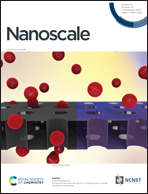Full and gradient structural colouration by lattice amplified gallium nitride Mie-resonators†
Abstract
The hybridised resonances between Mie-scatterers and lattice resonances, i.e. quasi-guided mode resonances, are investigated. The scattering of the Mie-resonators is improved by the first order of transmitted diffracted light which is coupled to the lattice formed by the Mie-resonators. The conditions of coupling are dependent on the refractive index of the substrate and the effective refractive index of the unit cell of the resonators. Based on the momentum matching conditions, the cut-off wavelength of coupling and the amount of the amplification can be controlled. As a proof-of-concept application of this framework, gallium nitride metasurfaces are designed to produce metasurfaces that display structural colour. Palettes of full spectral colour and gradients are successfully demonstrated. The hue of the colour can be controlled by changing the periodicity of the unit cell at a fixed filling ratio of Mie-scatterer radius to unit cell periodicity, since the increase in periodicity redshifts the cut-off wavelength of the lattice resonance conditions, identified as the Rayleigh anomaly. The brightness of the colour can be tuned by adjusting the filling ratio of the unit cell. Consequently, the proposed framework may provide a fundamental guideline to design spectral filters made up of low-index Mie-scatterers for various applications.



 Please wait while we load your content...
Please wait while we load your content...